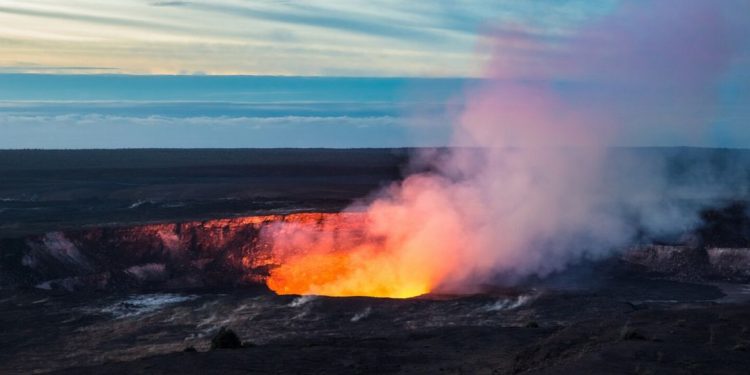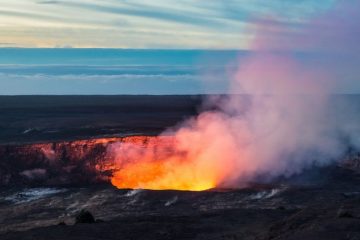
Hawaii Volcano Tours
One of the highlights of a visit to Hawaii is seeing the many volcanoes that dot the landscape. The islands that make up the Hawaiian chain were created by volcanic activity. The landforms we see above the surface of the ocean are actually the tops of giant volcanoes that formed by numerous eruptions over millions of years. Each of the Hawaiian Islands has at least one main volcano while many of them have more than one. The Big Island (named Hawaii) has five main volcanoes, including Mauna Loa, which is the largest active volcano on earth, and Kilauea which is notable for producing the most lava annually of any volcano on earth.
Volcanoes are classified as either active or extinct. Active volcanoes have erupted at least once in the past 10,000 years and inactive volcanoes have not. Active volcanoes are then further classified as either erupting or dormant. Out of the volcanoes on Hawaii, five are considered active with four of these being located on the Big Island. They include Mauna Loa, Mauna Kea, Kilauea and Hualalai. The other active volcano is located on Maui and is known as Mount Haleakala. A sixth active volcano, Loihi is submerged off the coast of the Big Island near Kilauea.
Hawaii is one of the best places on earth to get up close to active volcanoes and to experience the unique volcanic landscapes. There are several ways to see the volcanoes during your trip to Hawaii. Here we have outlined some of the most popular.
Hiking in Hawai’i Volcanoes National Park
One popular way to experience Hawaii’s volcanoes is by hiking to see the lava. This is particularly popular at the Hawai’i Volcanoes National Park. Day hikes in the park include a hike to the top of Pu’u Huluhulu Cinder Cone and hiking down to the floor of Kilauea caldera among others. Our favorite hike in Hawaii Volcanoes National Park is the Crater Rim Trail which circles the summit caldera of Kilauea. Here you will be blown away as you journey through a real, active volcano with steam vents and several overlooks.
If you want to see actual lava flows, the best way is to travel to the end of Chain of Craters Road where you can see the lava flows from a distance. Backcountry hiking is also available. Since the National Park contains active volcanoes, trail sections are often closed. For your own safety make sure to heed all posted signs and park ranger instructions and do not stray off of the trail. The entrance fee as of January 1, 2020 is $30 for a private, non-commercial vehicle for seven days and $15 for a pedestrian or bicycle.
Hike an Extinct Volcano on Oahu
On the Island of Oahu, you can also hike to see volcanoes including the incredibly popular Diamond Head. Bike Hawaii offers a guided hiking tour priced at $71 where you will explore an extinct volcano in the rainforest.
As you hike along the slopes of the ancient cinder cone volcano, you will enjoy stunning views of Oahu’s mountain ranges, the flora and fauna of the native forest and nice tropical island views as you gain 600ft of elevation. This hike is quite different than the volcano hiking tours on the Big Island as there is no flowing lava or steam vents here. However, it offers you an interesting opportunity to learn about volcanic landscape, get a bit of exercise and snap some amazing photos of the views. These hikes are great for kids too, so this is something the whole family can enjoy together!
Winter brings on a whole new level of fun activities to enjoy. These adventurous winter vacations will both challenge and delight you!
Haleakala Crater Bike Tours
Haleakala Crater is the largest dormant volcano in the world and Maui’s highest peak. It’s located in the Haleakala National Park. One of the most popular ways to experience Haleakala Crater is by taking a sunrise bike tour where you will usually be dropped off at the Pu’u’ula’ula Summit (Mount Haleakala’s highest point), will watch the sunrise and then bike down to the ocean. These sunrise tours offer an opportunity to experience the reddish-orange colored dawn at the peak and then also admire the landscape as you bike down. Alternatively, you can hike to see the crater. The crater tends to be crowded at both sunrise and sunset and much less busy at midday.
Volcano Air Tours
One of the best and most spectacular ways to see the volcanoes in Hawaii is by taking an air tour. There are companies offering both plane and helicopter tours on various islands. Blue Hawaiian Helicopters offers a Big Island Tour (priced from $243) where you can see the craters of Kilauea Volcano as well as the path of recent lava flows in Puna and more. They also offer a helicopter tour where you can fly over the three volcanoes Mauna Kea, Mauna Loa and Kilauea, and also get a close-up look at the lava flows and craters. This tour is priced from $569 and has an optional waterfall landing available for an even more exciting experience.
Tours by small plane are also on offer. While the big island has the most active volcanoes, you do not have to be staying there to experience the volcanoes. Various companies offer tours from nearby islands such as Oahu, Maui and Kauai that allow you to feel the excitement of the Big Island’s amazing volcanoes on a day tour.
If you are a traveler who is excited by wilderness, then Alaska is a destination for you. With beautiful nature, here is what to do in Alaska.
Lava Ocean Tours
Another way to experience the lava flows from a different point of view is to book a lava ocean tour. When the season and lava flow allows, various companies offer lava ocean tours. You’ll get to get close to the lava flow in a boat. The view of the bright orange lava flowing into the ocean is an amazing sight, especially if you see it right at sunrise or sunset when the light is low. The tour takes approximately three to four hours and includes about 30 minutes of active viewing time of the lava ocean entry. The sea can be quite choppy, so be aware if you are prone to seasickness. But the trip is all worth it when you get the view of the lava. These tours cost around $350 per passenger. Whether or not lava ocean tours are available is highly dependent on the lava flow and whether or not it is visible from the water at the time of your visit, so please double check with your tour company and plan accordingly.
